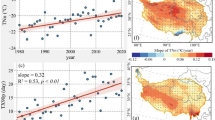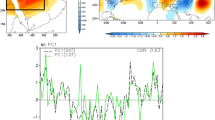Abstract
Under recent Arctic warming, boreal winters have witnessed severe cold surges over both Eurasia and North America, bringing about serious social and economic impacts. Here, we investigated the changes in daily surface air temperature (SAT) variability during the rapid Arctic warming period of 1988/89–2015/16, and found the daily SAT variance, mainly contributed by the sub-seasonal component, shows an increasing and decreasing trend over eastern Eurasia and North America, respectively. Increasing cold extremes (defined as days with daily SAT anomalies below 1.5 standard deviations) dominated the increase of the daily SAT variability over eastern Eurasia, while decreasing cold extremes dominated the decrease of the daily SAT variability over North America. The circulation regime of cold extremes over eastern Eurasia (North America) is characterized by an enhanced high-pressure ridge over the Urals (Alaska) and surface Siberian (Canadian) high. The data analyses and model simulations show the recent strengthening of the high-pressure ridge over the Urals was associated with warming of the Barents-Kara seas in the Arctic region, while the high-pressure ridge over Alaska was influenced by the offset effect of Arctic warming over the East Siberian-Chukchi seas and the Pacific decadal oscillation (PDO)-like sea surface temperature (SST) anomalies over the North Pacific. The transition of the PDO-like SST anomalies from a positive to negative phase cancelled the impact of Arctic warming, reduced the occurrence of extreme cold days, and possibly resulted in the decreasing trend of daily SAT variability in North America. The multi-ensemble simulations of climate models confirmed the regional Arctic warming as the driver of the increasing SAT variance over eastern Eurasia and North America and the overwhelming effect of SST forcing on the decreasing SAT variance over North America. Therefore, the regional response of winter cold extremes at midlatitudes to the Arctic warming could be different due to the distinct impact of decadal SST anomalies.
摘要
在近三十年北极快速增温的影响下, 频繁的寒潮侵袭欧亚和北美, 造成严重的社会、经济影响。本文分析了逐日气温变率在北极快速增暖时期1988/89-2015/16的变化, 我们发现次季节尺度分量贡献的逐日气温方差, 在欧亚东部呈现为显著的增加趋势, 而在北美呈现出显著的减小趋势。冷极值(定义为逐日气温偏冷1.5个标准差以上的天数)的增多主导了东亚逐日气温变率的增加, 而冷极值的减少主导了北美逐日气温变率的减小。欧亚东部冷极值对应的大气环流主要表现为乌拉尔高压脊增强和西伯利亚高压增强, 北美冷极值的大气环流主要表现为阿拉斯加高压脊增强和加拿大高压增强。资料分析和模式模拟结果表明, 乌拉尔高压脊的增强主要与巴伦支海和喀拉海地区的增暖相关, 而与海温异常的相关很弱。阿拉斯加高压脊的增强既受东西伯利亚和楚科奇地区的增暖的影响, 也受北太平洋类太平洋年代际振荡(PDO)型海温的作用。类似PDO型海温异常由正位相向负位相的转换抵消了北极增暖使阿拉斯加高压脊增强的影响, 减少了北美冷极值的发生频率, 由此导致北美逐日温度变率呈现出减小趋势。气候模式多集合模拟结果证实了北极增暖对欧亚东部和北美逐日气温方差增加的驱动作用, 以及海温异常强迫对北美气温方差减少的主导作用。因此, 我们认为, 由于北太平洋海温年代际异常的显著影响, 欧亚东部和北美地区冬季温度冷极值对北极增暖的区域响应表现出反向的变化特征。
Similar content being viewed by others
References
Cohen, J., 2016: An observational analysis: Tropical relative to Arctic influence on midlatitude weather in the era of Arctic amplification. Geophys. Res. Lett., 43, 5287–5294, https://doi.org/10.1002/2016GL069102.
Cohen, J., and Coauthors, 2014: Recent Arctic amplification and extreme mid-latitude weather. Nature Geoscience, 7, 627–637, https://doi.org/10.1038/ngeo2234.
Cohen, J., K. Pfeiffer, and J. A. Francis, 2018: Warm Arctic episodes linked with increased frequency of extreme winter weather in the United States. Nature Communications, 9(1), 869, https://doi.org/10.1038/s41467-018-02992-9.
Cohen, J., and Coauthors, 2020: Divergent consensuses on Arctic amplification influence on midlatitude severe winter weather. Nature Climate Chang, 10, 20–29, https://doi.org/10.1038/s41558-019-0662-y.
Dee, D. P., and Coauthors, 2011: The ERA-Interim reanalysis: Configuration and performance of the data assimilation system. Quart. J. Roy. Meteor. Soc., 137, 553–597, https://doi.org/10.1002/qj.828.
Ding, Q. H., J. M. Wallace, D. S. Battisti, E. J. Steig, A. J. E. Gallant, H. J. Kim, and L. Geng, 2014: Tropical forcing of the recent rapid Arctic warming in northeastern Canada and Greenland. Nature, 509(7499), 209–212, https://doi.org/10.1038/nature13260.
Dobricic, S., E. Vignati, and S. Russo, 2016: Large-scale atmospheric warming in winter and the arctic sea ice retreat. J. Climate, 29, 2869–2888, https://doi.org/10.1175/JCLI-D-15-0417.1.
Feng, C., and B. Y. Wu, 2015: Enhancement of winter arctic warming by the siberian high over the past decade. Atmos. Ocean. Sci. Lett., 8(5), 257–263, https://doi.org/10.3878/AOSL20150022.
Francis, J. A., and S. J. Vavrus, 2012: Evidence linking Arctic amplification to extreme weather in mid-latitudes. Geophys. Res. Lett., 39, L06801, https://doi.org/10.1029/2012GL051000.
Francis, J. A., S. J. Vavrus, and J. Cohen, 2017: Amplified Arctic warming and mid-latitude weather: New perspectives on emerging connections. Wires Climate Change, 8(5), e474, https://doi.org/10.1002/wcc.474.
Gao, Y. Q., and Coauthors, 2015: Arctic sea ice and Eurasian climate: A review. Adv. Atmos. Sci., 32, 92–114, https://doi.org/10.1007/s00376-014-0009-6.
Hao, M. J., Y. Luo, Y. L. Lin, Z. C. Zhao, L. Wang, and J. B. Huang, 2019: Contribution of atmospheric moisture transport to winter Arctic warming. International Journal of Climatology, 39(5), 2697–2710, https://doi.org/10.1002/joc.5982.
Honda, M., J. Inoue, and S. Yamane, 2009: Influence of low Arctic sea-ice minima on anomalously cold Eurasian winters. Geophys. Res. Lett., 36, L08707, https://doi.org/10.1029/2008GL037079.
Horton, D. E., N. C. Johnson, D. Singh, D. L. Swain, B. Rajaratnam, and N. S. Diffenbaugh, 2015: Contribution of changes in atmospheric circulation patterns to extreme temperature trends. Nature, 522(7557), 465–469, https://doi.org/10.1038/nature14550.
IPCC, 2012: Summary for policymakers. Managing the Risks of Extreme Events and Disasters to Advance Climate Change Adaptation, C. B. Field et al., Eds., Cambridge University Press, 3–21.
Ito, H., N. C. Johnson, and S. P. Xie, 2013: Subseasonal and inter-annual temperature variability in relation to extreme temperature occurrence over East Asia. J. Climate, 26(22), 9026–9042, https://doi.org/10.1175/JCLI-D-12-00676.1.
Kennedy, D., T. Parker, T. Woollings, B. Harvey, and L. Shaffrey, 2016: The response of high-impact blocking weather systems to climate change. Geophys. Res. Lett., 43, 7250–7258, https://doi.org/10.1002/2016GL069725.
Kim, H. M., and B. M. Kim, 2017: Relative contributions of atmospheric energy transport and sea ice loss to the recent warm arctic winter. J. Climate, 30, 7441–7450, https://doi.org/10.1175/JCLI-D-17-0157.1.
Kug, J. S., J. H. Jeong, Y. S. Jang, B. M. Kim, C. K. Folland, S. K. Min, and S. W. Son, 2015: Two distinct influences of Arctic warming on cold winters over North America and East Asia. Nature Geoscience, 8, 759–762, https://doi.org/10.1038/ngeo2517.
Lee, M.-Y., C.-C. Hong, and H.-H. Hsu, 2015: Compounding effects of warm sea surface temperature and reduced sea ice on the extreme circulation over the extratropical North Pacific and North America during the 2013–2014 boreal winter. Geophys. Res. Lett., 4, 1612–1618, https://doi.org/10.1002/2014GL062956.
Li, F., H. J. Wang, and Y. Q. Gao, 2015: Extratropical ocean warming and winter arctic sea ice cover since the 1990s. J. Climate, 28, 5510–5522, https://doi.org/10.1155/JCLI-D-14-00629.1.
Li, F., Y. J. Orsolini, H. J. Wang, Y. Q. Gao, and S. P. He, 2018: Atlantic multidecadal oscillation modulates the impacts of Arctic sea ice decline. Geophys. Res. Lett., 45, 2497–2506, https://doi.org/10.1002/2017GL076210.
Liu, J. P., J. A. Curry, H. J. Wang, M. R. Song, and R. M. Horton, 2012: Impact of declining Arctic sea ice on winter snowfall. Proceedings of the National Academy of Sciences of the United States of America, 109, 4074–4079, https://doi.org/10.1073/pnas.1114910109.
Ma, S. M., and C. W. Zhu, 2019: Extreme cold wave over East Asia in January 2016: A possible response to the larger internal atmospheric variability induced by Arctic warming. J. Climate, 32, 1203–1216, https://doi.org/10.1175/JCLI-D-18-0234.1.
Ma, S. M., C. W. Zhu, B. Q. Liu, T. J. Zhou, Y. H. Ding, and Y. J. Orsolini, 2018: Polarized response of east asian winter temperature extremes in the era of arctic warming. J. Climate, 31(14), 5543–5557, https://doi.org/10.1175/JCLI-D-17-0463.1.
Mori, M., M. Watanabe, H. Shiogama, J. Inoue, and M. Kimoto, 2014: Robust Arctic sea-ice influence on the frequent Eurasian cold winters in past decades. Nature Geoscience, 7, 869–873, https://doi.org/10.1038/ngeo2277.
Mori, M., Y. Kosaka, M. Watanabe, H. Nakamura, and M. Kimoto, 2019: A reconciled estimate of the influence of Arctic sea-ice loss on recent Eurasian cooling. Nature Climate Change, 9(2), 123–129, https://doi.org/10.1038/s41558-018-0379-3.
Palmer, T., 2014: Record-breaking winters and global climate change. Science, 344(6186), 803–804, https://doi.org/10.1126/science.1255147.
Palmer, T. N., 2013: Climate extremes and the role of dynamics. Proceedings of the National Academy of Sciences of the United States of America, 110(14), 5281–5282, https://doi.org/10.1073/pnas.1303295110.
Park, T.-W., C.-H. Ho, S.-J. Jeong, Y.-S. Choi, S. K. Park, and C.-K. Song, 2011: Different characteristics of cold day and cold surge frequency over East Asia in a global warming situation. J. Geophys. Res., 116, D12118, https://doi.org/10.1029/2010JD015369.
Rayner, N. A., D. E. Parker, E. B. Horton, C. K. Folland, L. V. Alexander, D. P. Rowell, E. C. Kent, and A. Kaplan, 2003: Global analyses of sea surface temperature, sea ice, and night marine air temperature since the late nineteenth century. J. Geophys. Res., 108, 4407, https://doi.org/10.1029/2002JD002670.
Rhines, A., K. A. McKinnon, M. P. Tingley, and P. Huybers, 2017: Seasonally resolved distributional trends of North American temperatures show contraction of winter variability. J. Climate, 30, 1139–1157, https://doi.org/10.1155/JCLI-D-16-0363.1.
Screen, J. A., 2014: Arctic amplification decreases temperature variance in northern mid- to high-latitudes. Nature Climate Change, 4, 577–582, https://doi.org/10.1038/nclimate2268.
Screen, J. A., and I. Simmonds, 2010: The central role of diminishing sea ice in recent Arctic temperature amplification. Nature, 464, 1334–1337, https://doi.org/10.1038/nature09051.
Screen, J. A., C. Deser, and L. T. Sun, 2015: Reduced risk of North American cold extremes due to continued Arctic sea ice loss. Bull. Amer. Meteor. Soc., 96(9), 1489–1503, https://doi.org/10.1175/BAMS-D-14-00185.1.
Screen, J. A., and Coauthors, 2018: Consistency and discrepancy in the atmospheric response to Arctic sea-ice loss across climate models. Nature Geoscience, 11(3), 155–163, https://doi.org/10.1038/s41561-018-0059-y.
Shepherd, T. G., 2016: Effects of a warming Arctic. Science, 353(6303), 989–990, https://doi.org/10.1126/science.aag2349.
Shiogama, H., M. Watanabe, Y. Imada, M. Mori, Y. Kamae, M. Ishii, and M. Kimoto, 2014: Attribution of the June-July 2013 heat wave in the southwestern United States. SOLA., 10, 122–126, https://doi.org/10.2151/sola.2014-025.
Sigmond, M., and J. C. Fyfe, 2016: Tropical Pacific impacts on cooling North American winters. Nature Climate Change, 6(10), 970–974, https://doi.org/10.1038/nclimate3069.
Stone, D. A., and Coauthors, 2018: A basis set for exploration of sensitivity to prescribed ocean conditions for estimating human contributions to extreme weather in CAM5.1-1degree. Weather and Climate Extremes, 19, 10–19, https://doi.org/10.1016/j.wace.2017.12.003.
Sun, L. T., J. Perlwitz, and M. Hoerling, 2016: What caused the recent “Warm Arctic, Cold Continents” trend pattern in winter temperatures? Geophys. Res. Lett., 43, 5345–5352, https://doi.org/10.1002/2016GL069024.
Swain, D. L., B. Langenbrunner, J. D. Neelin, and A. Hall, 2018: Increasing precipitation volatility in twenty-first-century California. Nature Climate Change, 8(5), 427–433, https://doi.org/10.1038/s41558-018-0140-y.
Takaya, K., and H. Nakamura, 2001: A formulation of a phase-independent wave-activity flux for stationary and migratory quasigeostrophic eddies on a zonally varying basic flow. J. Atmos. Sci., 58, 608–627, https://doi.org/10.1175/1520-0469(2001)058<0608:AFOAPI>2.0.CO;2.
Tokinaga, H., S. P. Xie, and H. Mukougawa, 2017: Early 20th-century Arctic warming intensified by Pacific and Atlantic multi-decadal variability. Proceedings of the National Academy of Sciences of the United States of America, 114(24), 6227–6232, https://doi.org/10.1073/pnas.1615880114.
Trenberth, K. E., J. T. Fasullo, G. Branstator, and A. S. Phillips, 2014: Seasonal aspects of the recent pause in surface warming. Nature Climate Change, 4(10), 911–916, https://doi.org/10.1038/nclimate2341.
van Oldenborgh, G. J., R. Haarsma, H. De Vries, and M. R. Allen, 2015: Cold extremes in North America vs. mild weather in Europe: The winter of 2013–14 in the context of a warming world. Bull. Amer. Meteor. Soc., 96, 707–714, https://doi.org/10.1175/BAMS-D-14-00036.1.
Wallace, J. M., and D. S. Gutzler, 1981: Teleconnections in the geo-potential height field during the Northern Hemisphere winter. Mon. Wea. Rev., 109, 784–812, https://doi.org/10.1175/1520-0493(1981)109<0784:TITGHF>2.0.CO;2.
Wallace, J. M., I. M. Held, D. W. J. Thompson, K. E. Trenberth, and J. E. Walsh, 2014: Global warming and winter weather. Science, 343(6172), 729–730, https://doi.org/10.1126/science.343.6172.729.
Wu, B. Y., 2017: Winter atmospheric circulation anomaly associated with recent arctic winter warm anomalies. J. Climate, 30, 8469–8479, https://doi.org/10.1175/JCLI-D-17-0175.1.
Zhang, X. D., C. H. Lu, and Z. Y. Guan, 2012: Weakened cyclones, intensified anticyclones and recent extreme cold winter weather events in Eurasia. Environmental Research Letters, 7(4), 044044, https://doi.org/10.1088/1748-9326/7/4/044044.
Zyulyaeva, Y. A., J. H. P. Studholme, and I. I. Zveryaev, 2019: Long-term changes in wintertime temperature extremes in Moscow and their relation to regional atmospheric dynamics. J. Geophys. Res., 124, 92–109, https://doi.org/10.1029/2018JD028642.
Acknowledgements
This study was jointly supported by the National Key R&D Program (Grant No. 2018YFC1505904), the National Natural Science Foundation of China (Grant Nos. 41830969 and 41705052), and the Basic Scientific Research and Operation Foundation of CAMS (Grant No. 2018Z006).
Author information
Authors and Affiliations
Corresponding author
Additional information
Article Highlights
• The regional daily SAT variability shows opposite trends over eastern Eurasia and North America.
• Increasing and decreasing cold extremes dominated the increase and decrease of the daily SAT variability over eastern Eurasia and North America, respectively.
• The regional differences are orchestrated by the compounding effect of Arctic warming and extratropical SST anomalies.
Rights and permissions
About this article
Cite this article
Ma, S., Zhu, C. Opposing Trends of Winter Cold Extremes over Eastern Eurasia and North America under Recent Arctic Warming. Adv. Atmos. Sci. 37, 1417–1434 (2020). https://doi.org/10.1007/s00376-020-0070-2
Received:
Revised:
Accepted:
Published:
Issue Date:
DOI: https://doi.org/10.1007/s00376-020-0070-2
Key words
- daily surface air temperature variability
- extreme cold days
- Arctic warming
- eastern Eurasia
- North America




